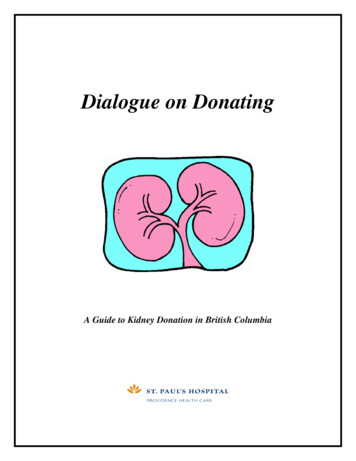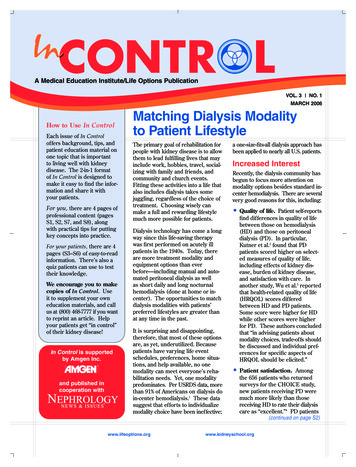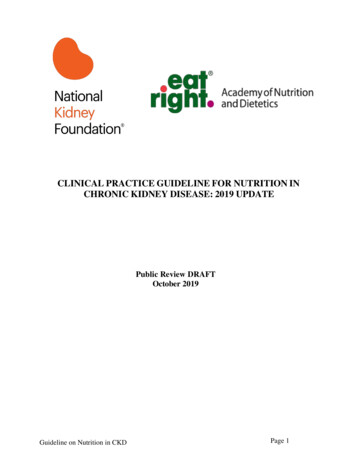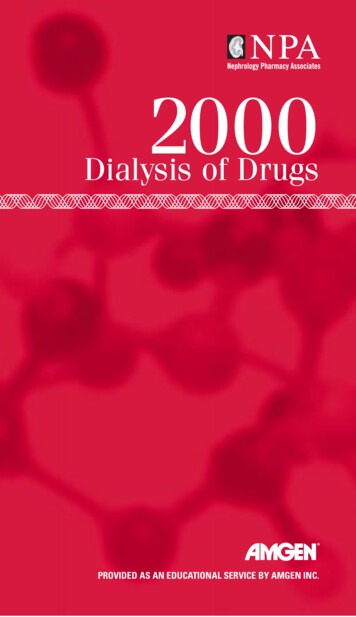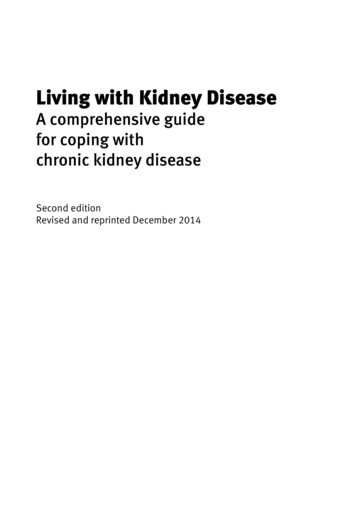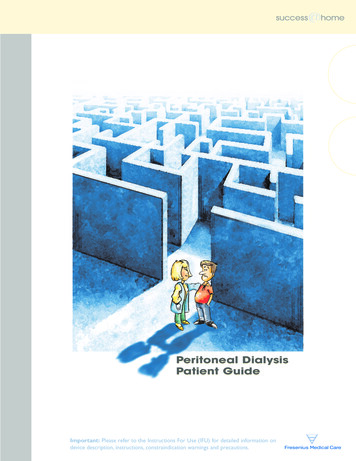
Transcription
Peritoneal DialysisPatient GuideImportant: Please refer to the Instructions For Use (IFU) for detailed information ondevice description, instructions, constraindication warnings and precautions.
Peritoneal Dialysis patient guide
page1Contents1. Introduction — page 32. Normal Kidney Function — page 43. Chronic Kidney Failure — page 54. Common causes of Kidney Failure — page 65. Understanding Peritoneal Dialysis — page 7Basic PrinciplesPeritoneal MembraneOsmosisDiffusionUltrafiltration6.The Peritoneal Dialysis Exchange — page 10PD CatheterPD ExchangeDialysis SolutionAdding Medication to the Dialysis SolutionTypes of Peritoneal DialysisCAPDCCPDPD Plus7. Preparing for Peritoneal Dialysis — page 18Aseptic TechniqueYour Work AreaGathering SuppliesWarming DialysateMasking and Hand WashingAdding MedicationsDisposing of Effluent and Used SuppliesHelpful Hints8.Your Daily Routine — page 25Vital SignsBlood PressurePulseTemperatureWeightDaily Exit Site CareRecord Keeping
page2Peritoneal Dialysis patient guideContents9. Complications — page 33Infectious ComplicationsPeritonitisExitTunnelNon-Infectious ComplicationsFillingDrainingBlood-Tinged EffluentConstipationFluid OverloadDehydrationShoulder PainHerniaItching10. Medications — page 4111. Nutrition — page 4512. Living With Dialysis — page 4913. Follow-up Care — page 51Clinic VisitsLab Tests14.Your Dialysis Supplies — page 5715. Commonly Asked Questions — page 6016. Glossary — page 64
page3IntroductionThe purpose of this patient guide is to present you withinformation about peritoneal dialysis (PD). Fresenius MedicalCare North America has prepared this manual as an aid tothe excellent care offered by your dialysis team which consistsof your doctor, nurse, dietitian and social worker.It will take a firm commitment from you to accept theresponsibility of carrying out your prescribed treatment planexactly as you have been taught. Besides learning how toperform peritoneal dialysis, you will learn how to recognizepotential problems and how to respond correctly.Yourresponsibilities will also include taking your medications andfollowing your diet as instructed.This guide is just part of your training. Feel free to make notesas you learn about PD.You will also find this to be a helpfulresource once you are home. If you have any questionsabout the information in this manual, please ask your hometraining nurse.
page4Peritoneal Dialysis patient guideNormal Kidney FunctionThe KidneysThe kidneys are two organs that are located in the lower back,one on each side of the spine.They are about the size of aclenched fist.The kidneys have numerous functions that arevital to your well being.Their main function is to rid the bodyof extra fluid and waste products. Everyone has waste productswhich result from digestion of food.The kidneys filter thesewaste products and get rid of harmful waste through urine.Theuseful products are left in the body.The kidneys help regulate the body’s water balance.They alsorelease hormones which help make red blood cells and controlblood pressure. Another important balance that is affected bythe kidneys is calcium, phosphorus and vitamin D, which worktogether to play a key role in bone formation.Some of the functions of the kidneys are to: Remove extra fluid Remove waste products Restore needed chemicals Regulate blood pressure Help red blood cell production Help with calcium and vitamin balance
page5Chronic Kidney Failure (CKF)As kidney failure begins, the kidneys are not able to clean theblood of waste products.These toxins and excess water collectin the body. A build up of waste products in the blood is calleduremia. Some of the symptoms of kidney failure that you mightfeel include: Extreme tiredness Nausea and vomiting Difficulty sleeping Puffiness and swelling of the feet, legs,hands and face Shortness of breath Bad breath High blood pressureYou may experience all or one of these symptoms.Chronic kidney failure means that the loss of kidney functionis permanent. Kidney function may stop quickly or slowly failafter a number of years. End Stage Renal Disease or ESRDoccurs when the kidneys have reached the point where theycan no longer work well enough to maintain the balancesneeded for life.This is usually when dialysis must be started.
page6Peritoneal Dialysis patient guideCommon Causesof Kidney FailureThere are many causes of kidney failure and a few of the mostcommon reasons are listed here: Diabetes Glomerulonephritis Pyelonephritis Lupus Erythematosus Hypertension Obstruction Polycystic Kidney Disease Structural DisordersDiabetes – This causes blood vessel changes in the kidneys(and the whole body).This process occurs over many years.The kidney failure is caused by a thickening and hardeningof renal arteries, glomeruli and tubules.Glomerulonephritis – This is the single most common causeof chronic kidney failure. In this disease there is inflammation anddestruction of the glomerulus in the kidneys.Lupus Erythematosus – Lupus is a chronic inflammatorydisease of the body tissue which causes scarring.The scarringin the kidney leads to kidney failure.Obstruction – This can occur with kidney stones. If urine isnot able to drain well and backs up into the kidneys, there canbe damage to the kidneys.Polycystic Kidney Disease – In this condition, the kidneysare full of cysts that slowly enlarge then press against theworking parts of the kidney causing damage.This is aninherited condition.Pyelonephritis – This is an infection of the kidneys. Repeatedinfections may damage the nephrons causing kidney failure.Structural disorders – This is from a defect in the urinarytract.This is usually present at birth.This can cause urine toback up into the kidneys and cause damage.
page7UnderstandingPeritoneal DialysisBasic PrinciplesPeritoneal dialysis (PD) is one of several ways to treat kidneyfailure. PD is close to the natural function of the kidneys. It ridsthe body of waste products, extra fluid and helps balancechemicals in a slow and gentle way.In order for dialysis to take place, there must be a membranewith tiny holes (pores) to filter waste products from the blood.This membrane must be semi-permeable, meaning wasteproducts can pass through but the substances that your bodyneeds will not.Peritoneal dialysis uses the peritoneal membrane as an“artificial kidney.” This membrane—also called the peritoneum—is very thin and lines the abdominal cavity and covers mostof the internal organs.The peritoneum acts as the dialyzingmembrane.The peritoneal membrane has many small blood vessels(capillaries).When dialysis solution is put into the peritonealcavity, waste products and excess fluid pass from the bloodto the dialysis solution.The processes that make this happenare osmosis, diffusion and ultrafiltration.
page8Peritoneal Dialysis patient guideWaste productsOsmosisOsmosis is the process that allows excess water to beExcess waterremoved from the blood.With osmosis, the body tries to makethe water balance on both sides of the membrane.Water willmove from an area that has the largest amount of water(least concentrated), to an area that has the smallest amountof water (the most concentrated).Dialysis solution contains dextrose, a simple sugar.This sugardraws excess fluid from the blood into the dialysis solution.Your blood will usually be less concentrated (have more waterPeritoneal membraneand less dextrose) than the dialysis solution.This means thatthe extra water in your blood will move across your peritonealmembrane into the dialysis solution.DiffusionWaste products and extra chemicals are removed from theblood through a process called diffusion.The dialysis solutionhas no waste products and contains the proper amount ofchemicals.When the solution is put into the peritoneum, thewaste products and extra chemicals are drawn from the bloodinto the solution until they are equal. Once the blood anddialysis solution become equal, no dialysis is taking place.An example of this is to think of a cup that is divided by asemi-permeable membrane. On one side is water with a largeamount of salt (sodium). On the other side is solution thatcontains little salt.The salt particles on the concentrated sidewill slowly move to the side that has little salt.When there isthe same amount of salt on both sides of the membrane, themovement stops.
page9UltrafiltrationUltrafiltration means that an extra amount of water wasremoved.This is done in PD by using dialysis solution with anincreased concentration of dextrose, a type of sugar.The moredextrose that is in the dialysis solution, the more water thatwill be removed from your blood.Dialysis solution comes in three different strengths: 1.5% dextrose 2.5% dextrose 4.25% dextroseDuring training, you will learn when you should use thedifferent strength solutions.
page10Peritoneal Dialysis patient guideThe PeritonealDialysis ExchangeThe PD CatheterTo fill and drain the peritoneal cavity of solution, a soft plastictube called a catheter is inserted through the abdomen, into theperitoneum and sewn in place.The catheter is placed by asurgeon or nephrologist in the operating room or specialtreatment room. It is a simple and short process. Once thecatheter has been placed, you may have a few days of discomfortwhere the opening was made.You will have a large dressing over the site of catheterplacement.The dialysis staff or a trained nurse at the doctor’soffice will perform the first few dressing changes.The catheteris normally rested for a few days to a few weeks before usingit for dialysis.This is needed to prevent the dialysis solutionfrom leaking.The doctor may order your catheter to be flushed duringthis time. A small amount of solution will be instilled (putthrough the catheter) into your peritoneal cavity thenimmediately drained.Once the catheter is healed, you will be instructed on how tocare for the catheter exit site (the skin around your catheter)by your dialysis nurse. He/she will instruct you on general exitsite care, bathing, swimming and securing the catheter.
page11The PD ExchangeAn exchange is the process of draining the peritoneal cavityof old dialysis solution, filling with the new solution, thenallowing it to dwell.You are exchanging old dialysis solutionwith new dialysis solution. Let’s take a closer look at theexchange process:Drain – The fluid containing the waste and excess fluid isdrained out.This can take approximately 15-20 minutes.Fill – Fresh solution is put into the peritoneal cavity throughthe catheter. It usually takes 5-10 minutes to fill.DrainDwell – Dialysis occurs during the dwell time.The fluid willstay in the peritoneal cavity for a set number of hours.Yourdoctor will decide how many hours the fluid should dwell.During the first few exchanges you may have a feelingof fullness when you fill. After a while, that feeling will goaway and the feeling of fluid in your peritoneal cavity willbecome routine.FillYour doctor will determine how much fluid you will use duringeach exchange and how many exchanges you will do each day.Your doctor and nurse will help you make a schedule that willsuit your needs.You can continue your normal daily activitieswhile you carry the dialysis solution within you.With PD, youcan plan your dialysis around your normal routines instead ofchanging your routine to suit your dialysis.Dwell
page12Peritoneal Dialysis patient guideDialysis SolutionsDialysis solution is made up of: Sterile water Chemicals/electrolytes DextroseThere are several different strengths and bag sizes of dialysissolution.Your doctor will decide which type and size is bestfor you.The most common sizes are: 1 liter 1.5 liter 2 liter 2.5 liter 3 liters 5 liter (for cycling patients)The solution bag has a dextrose percentage (%) numberprinted on it.The higher the number, the more dextrose(sugar) there is in the bag and the “stronger” thesolution is. 1.5% solution has the lowest amount of sugar and is usuallyused by patients who gain a small amount of fluid weight. 2.5% solution is usually used by patients who gain2-3 pounds of fluid over their dry weight. 4.25% solution has the highest amount of sugar and is usuallyused by patients who gain more than 3 pounds of fluid overtheir dry weight.The strength of solution that you use will depend on theamount of extra water that needs to be removed.The greaterthe amount of extra fluid that needs to be removed from yourbody, the higher the percent of solution you should use.
page13The following are examples of what a two liter bagof solution might remove: 1.5% dextrose – removes about 100-300ccof extra fluid 2.5% dextrose – removes about 300-500ccof extra fluid 4.25% dextrose – removes about 600-800ccof extra waterYour doctor and PD nurse will instruct you in the selection ofthe best dialysis solution for you.This is based on your weight,blood pressure and according to your symptoms and responseto the dialysis therapy. Many patients use more than onestrength of solution.Every time you perform a dialysis exchange, you must checkthe solution bag before using it.You can use the word “SCALE”as a clue to the checks you need to do. S: Strength – be sure that you have selected the correctstrength of dextrose (1.5%, 2.5% or 4.25%) C: Clarity – the solution should be clear. A slight yellowcolor is acceptable.There should not be any particles inthe bag. A: Amount – check the bag size to be sure you will receivethe amount of fluid that your doctor has ordered. L: Leaks – wipe off any moisture from the surface of thebag, then squeeze the bag to check for leaks. Do not use ifthere is a leak in the bag. Report this to your PD nurse. E: Expiration date – do not use the solution past theexpiration date.
page14Peritoneal Dialysis patient guideTypes of Peritoneal DialysisThere are three types of peritoneal dialysis: ContinuousPeritoneal Dialysis (CAPD), Continuous Cycling PeritonealDialysis (CCPD) and PD Plus dialysis which is a cross betweenCAPD and CCPD. All of these types of dialysis can be doneat home.Continuous Ambulatory Peritoneal Dialysis(CAPD)This type of dialysis is continuous because you have fluid inyour peritoneal cavity 24 hours a day, seven days a week. Itallows you to move around freely, just as you normally would.CAPD is a type of dialysis that you can do by yourself anddoesn’t require any machines. It takes approximately 35minutes to perform a CAPD exchange.Your doctor willprescribe how many exchanges per day you will need tobe properly dialyzed. Most patients do 4 to 5 each day.An exchange involves three steps: Drain: At the end of the dwell time, you will set up a newwarmed solution bag and connect to your PD catheter.Thedialysate will flow into the drain bag from your peritonealcavity by gravity. Remember that drained dialysate solution iscalled effluent. It takes about 20 minutes to drain.When youare performing CAPD on a regular basis you will always drainout the effluent before filling.
page15 Fill: Warmed dialysate solution is connected to the tubingset attached to your peritoneal catheter.The solution flowsby gravity through the tubing into your peritoneal cavity.It takes about 10 minutes to fill. You will disconnect yourperitoneal catheter from the solution tubing after the fillis complete. Dwell: When the dialysate solution is in your peritonealcavity, dialysis takes place.Waste products and excess fluidare pulled from your blood through the peritoneal membraneand into the dialysate.You may continue all normal activitywhile you dwell. Dwell times vary from 4-6 hours during theday and 8-10 hours at night.Exchange times can vary somewhat to fit your schedule,especially if you work or go to school.Your PD nurse will helpyou set a schedule that works best for you. A typical scheduleis, 7 am, 12 noon, 5 pm and 10 pm.
page16Peritoneal Dialysis patient guideContinuous Cycling Peritoneal Dialysis(CCPD)This therapy uses a machine called a cycler.While you aresleeping, the cycler does your dialysis exchanges for you.The cycler automatically measures and warms fresh dialysissolution.This solution then flows by gravity through tubinginto your peritoneal cavity. After the prescribed amount ofdwell time, the used solution drains by gravity into a weighbag on the cycler.The cycler automatically repeats theseexchanges that have been prescribed by your doctor. All ofthis is done while you sleep. It takes about eight to ten hoursto perform CCPD. In the morning, you disconnect from thecycler and go about your normal routine. Most of the time,you will have a small amount of dialysate in your peritonealcavity during the day. CCPD can be done alone or with apartner.This is a very useful form of dialysis treatment forpeople who work or go to school. Not everyone is acandidate for CCPD.You and your doctor will decide if thisis a modality choice best for you.
page17PD Plus Peritoneal DialysisPD Plus is a combination of CAPD and CCPD. It requires acycler that provides automatic dialysis treatments during thenight while you sleep and also allows you to do any CAPDexchanges that you may need during the day right from themachine.This therapy is usually performed by patients whoneed more dialysis than can be covered with CAPD or CCPDalone. Once the machine is set up during the day, you willconnect to the cycler tubing and perform a daytime exchange.The machine will drain and fill you automatically, then you willdisconnect from the machine.The machine remains ready forany further daytime exchanges or to be connected to you atbedtime. Some patients perform more than one daytimeexchange from their cycler.
page18Peritoneal Dialysis patient guidePreparing forPeritoneal DialysisWhether you are performing CAPD, CCPD or PD Plus, thereare basic principles that must be followed.Aseptic TechniqueGerms and bacteria are found on almost everything. Germsand bacteria are so small you cannot see them. Something thatis completely free from germs or bacteria is called sterile oraseptic.The peritoneal cavity is sterile.Your solution bag andthe connections of your PD system are also sterile.You mustfollow all procedures carefully so that germs or bacteria donot get into your peritoneal cavity or your PD system andcause an infection. Everything you do with your catheter, exitsite, or during your exchange procedure must be done ascleanly (aseptically) as possible.You must be extremely carefulnot to contaminate (allow germs in) by touching, dropping,coughing or breathing on these areas. Any dropped suppliesmust be thrown away. Remember that germs multiply rapidlyin warm, moist , dark, “sugary” areas such as your peritonealcavity. If bacteria enters into your peritoneal cavity, there is agood chance of getting an infection called peritonitis.
page19Your Work AreaThe area you choose to do your exchanges should be largeenough to hold the necessary supplies for your exchangeprocedure. It needs to be kept clean and uncluttered withgood lighting.Extra supplies should be easy to reach. During the exchangeprocedure, there should not be any open windows.Turn off airconditioners or fans. Do not do an exchange in a high trafficarea. Air movement carries germs in dust particles and cancause a contamination. Pets should not be in the room whenyou are doing your exchange.Everyone in the room needs to wear a mask. It’s importantto avoid distractions. If you are distracted, you may make amistake and contaminate your PD system. Following the stepsof your exchange, as you have been taught by your PD nurse,will help you avoid mistakes.Gathering SuppliesThe table that you use to perform your dialysis on must bedisinfected in between each exchange.Your PD nurse willinstruct you on how to do this.The disinfectant that you willuse is part of your dialysis supplies. Gather all the supplies thatyou will need to perform your exchange. Keep extra suppliesnearby.You should not have to interrupt your exchangeprocedure to get extra supplies.Your PD nurse will supplyyou with a list of items that you will need to perform yourdialysis exchange.Other supplies that you will need are a: Floor scale Spring scale I.V. pole Blood pressure cuff Thermometer Heating pad to warm the solution
page20Peritoneal Dialysis patient guideWarming DialysateEach bag of dialysate should be warmed up to body temperaturebefore it is infused into your peritoneal cavity.You will find thatwarm dialysate feels more comfortable as it fills your peritonealcavity but there is also another advantage of warmed dialysate –the removal of waste products and extra fluid begins morequickly when the dialysate is already warmed to bodytemperature before infusing it.The best way to warm a solution bag is by dry heat, such asa heating pad.You will be provided one with your dialysissupplies.Your PD nurse will instruct you on how to accomplishthis in the safest and most effective way. Do not warm thebags in hot water since there may be bacteria in the water.A water droplet in one of the connections could causeperitonitis. Microwave ovens must not be used because theyheat unevenly and can overheat the solution. Overheatingsolution can damage your peritoneum.Masking and Hand WashingMasking is a very important part of aseptic technique.Thereare germs that normally live in your nose and mouth. If thesegerms manage to get onto your PD connections, they couldtravel to your peritoneal cavity and cause peritonitis.Wearing amask during your exchange procedure helps to prevent thosegerms from contaminating your PD system.
page21REMEMBER: Mask before washing your handsand make sure that the mask covers your noseand mouth.You will be taught the best way to wash your hands in orderto remove as many germs as possible from between yourfingers, under your nails and up to your wrist.If you touch something that is not clean with your freshlywashed hands, such as putting on your mask or scratching anitch, then your hands are no longer clean.They must bewashed again. Good hand washing involves a one minute scrubwith antibacterial soap from a pump bottle. Dry your handsthoroughly using paper towels. Cloth towels are discouragedunless a clean one is used each time you wash your hands.REMEMBER: Wash your hands first before touching yourcatheter, exit site or PD connections.
page22Peritoneal Dialysis patient guideAdding Medications to theDialysis SolutionThere may be times that you will have to add medication toyour dialysis solution.The most common medications used areantibiotics for treating infections, heparin for preventing fibrinformation and regular insulin for better blood sugar controlin diabetics.Adding medications to the dialysis solution is a STERILEprocedure.Your home training nurse will instruct you on howto perform this procedure.Things to remember when addingmedication to the dialysis solution are: You must wash your hands and wear a mask duringthe procedure The medication port of the solution bag and the top of themedication bottle must be disinfected before drawing up andinjecting the medication After injecting, gently shake the solution bag to mixthe medication. The solution usually must remain in your peritonealcavity for at least 4 to 6 hours to absorb the medication.REMEMBER: If you do not follow sterile techniquewhile adding medication to the dialysis solution, youcould inject bacteria into the bag and cause aperitonitis infection.
page23Disposing of PD Effluent andUsed SuppliesYour dialysis unit may have a specific procedure for disposingof your used PD supplies.Your training nurse will tell you ifthere are any city, state, or federal environmental rules thatneed to be followed.In most instances, you can follow a few simple steps:1. Do not throw the full used solution bag in trash.2. Carefully drain the used solution into the toilet.3. Try to avoid spilling the used solution.4. Throw away the empty bag and used tubing in theregular trash.REMEMBER: Check with your PD nurse for anyspecial procedures.
page24Peritoneal Dialysis patient guideHelpful Hints for Performing YourPD Exchange The room should be large enough for all thedialysis supplies The room should be away from family activity The room should be dust free and free from clutter The room should have good lighting Your table should be wiped with disinfectant beforeeach exchange. Formica, laminate and glass areeasy to clean tabletops and will not be damaged bythe disinfectant. Do not allow pets in the room during your exchanges Sit in a comfortable chair when doing CAPD Close all doors and windows Turn off ceiling fans Shut off air conditioning or heater vents Gather all your supplies before you start If anything falls on the floor, do not use it Concentrate on what you are doing
page25Your Daily RoutineOnce home, you will have a few tasks to do every day,besides your dialysis.They include: your vital signs (bloodpressure, weight, pulse and temperature), exit site care andrecord keeping.Vital SignsVital signs show how your body is reacting to treatment andhow well your body is doing at that particular time. By takingyour vital signs every day you will quickly learn what is normalfor you.You can often detect changes through vital signs.Theywill also help you to decide what strength solution you shoulduse.Your nurse will show you how to correctly measure yourvital signs.Blood Pressure:Blood pressure (B/P) is the force made by the volume of bloodon the blood vessel walls and chambers of the heart. Highblood pressure is called hypertension. High blood pressure canoccur because of pain, being upset, or the aging process of theblood vessels.However, fluid overload (too much water in the body) is avery common cause of high blood pressure. Some signs offluid overload are: Headaches Swollen ankles, feet, legs, fingers, hands and face (edema) Shortness of breath
page26Peritoneal Dialysis patient guideLow blood pressure is called hypotension. Dehydration(not enough fluid in the vessels) can cause low blood pressure.If your blood pressure drops, it can be because too muchwater and sodium were removed. Blood pressure medicationcan also cause low blood pressure.The signs of low bloodpressure are: Dizziness – especially when standing quickly Blurred vision Nausea FaintingFor both high blood pressure and low blood pressure youshould notify your dialysis unit. A change in strength ofdialysis solution may be needed. If you are on blood pressuremedication, your doctor may need to change the dose.DO NOT change your blood pressure medication withouttalking with your doctor first.Taking Your Blood Pressure:You will be given either a stethoscope and blood pressurecuff or a digital blood pressure monitoring system.When youtake your blood pressure, you will have two numbers.Theyare written like this: 120/80.The first number (or the numberon top) is the systolic pressure.This occurs as the heartcontracts and pushes blood through the vessels; the heartat work. A normal systolic pressure is about 120mmHg(millimeters of mercury).The other number (or number onbottom) is called the diastolic pressure.The diastolic pressureoccurs as the heart relaxes between contractions. A normaldiastolic is about 80mmHg.Your nurse will teach you how to place the cuff andstethoscope or position the digital monitor correctly andgive you full instructions on how to monitor and documentyour blood pressures.
page27Here are a few things to remember when taking yourblood pressure: Remove all clothing from your upper arm You should be in a sitting position Avoid exertion before taking your blood pressure(this can effect the results) If possible, measure on the same arm If you are on blood pressure medicine, measure at the sametime every day (or more often if you are not feeling well) When positioning the cuff on your arm, the lower partof the cuff should be about 1” above the elbow Once positioned, you should be able to fit 2 fingers betweenyour arm and cuffWith practice, it does become easier. Sometimes bloodpressure changes occur over long periods of time.While youmay not be able to feel these slow blood pressure changes,they can be seen in your daily blood pressure records.High and low blood pressures cannot be ignored. It is veryimportant to take your blood pressure as advised by yourdoctor and/or nurse.PulseThe number of times your heart beats in one full minute isyour pulse.The normal pulse averages 60-90 beats per minute.Your pulse should be strong and regular.When your heart beatsfaster, your pulse increases and when your heart beats sloweryour pulse decreases.Your pulse rates will increase if you are excited, in pain orhave an infection. It will also increase if your dialysis treatmentremoves too much fluid from your body.
page28Peritoneal Dialysis patient guideYour doctor or nurse may instruct you to monitor your pulsedaily.Taking your pulse accurately is important.To find yourpulse, place your first 3 fingers over your wrist at the base ofyour thumb. (Do not use your thumb because your thumb hasa pulse of its own.) When you feel your pulse, count thenumber of beats that occur in one full minute. Use the secondhand of a clock or watch. Notice if the beats are regular orirregular.Write your pulse in your daily records. If your pulseis below 60 or above 120, notify your doctor or nurse.TemperatureYour temperature is an important indicator of infection.Your doctor or nurse may want you to take your temperatureon a daily basis.Normal body temperature is 98.6 degrees Fahrenheit. Dialysispatients can have a lower than normal body temperature.Youshould become familiar with what is normal for you.You shouldtake your temperature anytime that you feel warm or chilled.A higher than normal temperature can mean an infection orthe flu. If you have a rise in temperature along with a cloudy bagof drainage, you should suspect peritonitis and call your doctoror nurse immediately.You will be given either a glass
Peritoneal dialysis (PD) is one of several ways to treat kidney failure.PD is close to the natural function of the kidneys.It rids the body of waste products,extra fluid and helps balance chemicals in a slow and gentle way. In order for dialysis to take place,there must be a membrane with ti
